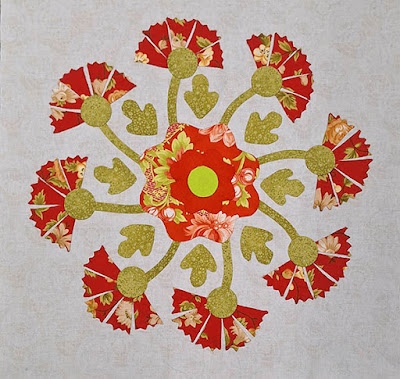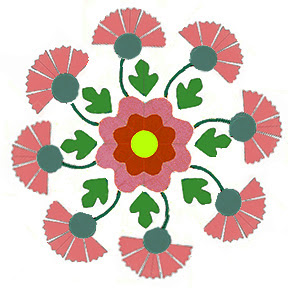Mary Ellen Marcy (1838 - 1907) & husband
George B. McClellan in 1862
When the Civil War began Nellie McClellan was in her early 20s living in Cincinnati. Married about a year to George McClellan, president of the Ohio & Mississippi Railroad, she was pregnant with her first child Mary (May.) By the time May was born in October West Point graduate George had returned to the Army where he'd served under General Winfield Scott during the Mexican War of the 1840s.
Generals McClellan, Banks & Wool behind
seated General Scott, who could hardly stand
much less ride a horse when appointed head of
Union armies in 1861.
Scott appointed McClellan a major general, commander of the Department of the Ohio. Scott had great faith in George's skills in military strategy as did President Abraham Lincoln, who knew George from their railroad interests in the west.
Brady Studios
The President and the Union Army's top ranking general in
October, 1862. McClellan's tent includes a woven coverlet for
a bedcover.
May was born to a father who was now head of the new Army of the Potomac, charged to defend Washington and march on to Richmond, replacing his former commander Scott too infirm for the position.
 Leslie's Illustrated, September, 1862
Leslie's Illustrated, September, 1862
McClellan loved the attention, writing Nellie in July, 1861:
"I find myself in a new & strange position here---Predt, Cabinet, Genl Scott & all deferring to me....I almost think were I to win some small [military] success now, I could become Dictator."
March, 1862
During the winter, women in Rochester, New York's Union Aid Society were so enamored of him they sent a quilt---not one they'd made--- but an antique supposedly pieced of fabrics from George Washington's home. On Washington's Birthday in 1862 McClellan thanked them promising he would use it in the field.
Collage of McClellan at his Alexandria. Virginia
headquarters with Nellie and her mother in the doorway,
May and her nursemaid at the window
George's great popularity did not last. He was good at strategy, at training an army, at looking like a hero but he would not attack for fear of losing that army (or his reputation.) His Peninsula Campaign was soon ridiculed.
Lincoln replaced him with Ambrose Burnside a month after Brady's field photo. McClellan remained in the Army but the days of glory were over. In March, 1863 Lincoln complained in print:
"I directed McClellan peremptorily to move on Richmond. It was eleven days before he crossed his first man over the Potomac; it was eleven days after that before he crossed the last man. Thus he was twenty-two days in passing the river at a much easier and more practicable ford than that where Lee crossed his entire army between dark one night and daylight the next morning. That was the last grain of sand which broke the camel's back. I relieved McClellan at once."
During the war Nellie lived in Ohio and New Jersey where they eventually built a home "Maywood" in the 1870s near her relatives in West Orange.
At some point she gave birth to a boy Walter Livingston McClellan who did not live long. Birth and death dates unknown---did he actually exist?
Campaign buttons, Cornell University
Although George protested he did not want to be president he accepted the Democrat Party's nomination in 1864, running against his old friend and now antagonist Lincoln who was seeking a second term nominated by what was called the National Union Party. From our perspective the McClellan/Pendleton platform is surprising if not shocking. Once in office they'd repeal the Emancipation Proclamation, send Union armies home and give the Confederacy independence as a slave-holding country---a complete capitulation to the South.
Running mate Ohio Senator George Pendleton had a history of hard-line pro-slavery politics. He was known as a leader of the conservative "Extreme Peace Democrats," nicknamed Copperheads and had favored expansion of slavery into the western territories in the 1850s. Worried National Union Party members suggested Lincoln be replaced as candidate by Generals Grant or Butler.
In August, 1864 the war was not going well for Lincoln.
Nellie's husband was never known for strong political convictions
but he did what he could for the ticket---if flip-flopping a few times---
and many observers were convinced Lincoln would lose to the General.
Lincoln, "bewildered and confounded," opinion from the New York
World, widely copied in September, 1864.
After three years the Union was war-weary, Lincoln himself among the weariest. He worried about the North, which he realized was "divided and partially paralyzed by a political war among themselves."
Holmes County (Ohio) Farmer
Inflation was outrageous.
No incumbent had won a second term since Andrew Jackson over 30 years earlier. Straw polls predicted McClellan's Peace Party victory. In a mock election at Columbian College McClellan led Lincoln by 46 to 12.
Kentucky indeed voted for McClellan as predicted
Lincoln won by a small percentage in New York.
There were no uprisings, no riots in the streets.
October, 1864. The influential Springfield Republican tells us the
only poll that counts is on election day.
By November Sherman, Sheridan and Grant's Army of the Shenandoah were winning battles. The war termed a failure was beginning to look like a victory.
As this Encyclopedia Britannica map shows, McClellan won three states: Delaware, Kentucky and New Jersey. Popular vote: Lincoln: 2,216,067; McClellan 1,808,725.
Leslie's Illustrated
What could have happened? How could the Copperheads have lost?
McClellan's Own Story tells us of widespread voter fraud in the 1864 election. Lincoln's Secretary of War Edwin Stanton, who truly did despise him, was accused of destroying soldiers' votes for the peace candidates.
McClellan's Own Story by W. C. Prime
The popular vote spread differed by over 400,000.
Immediately after defeat McClellan resigned from the Union Army and he and Nellie made plans to move to Europe, where they remained for several years. George Brinton McClellan II was born in Germany in November, 1865.
Elizabeth Bacon Custer, who knew a lot about public relations,
wrote a tribute to the McClellan marriage after George died.
Here she casts Nellie at the "gates of death" from grief after her
husband's election loss.
Highly unlikely!
The McClellans returned to the United States in the 1870s where George assumed lucrative leadership in railroads and other private firms. He was elected Governor of New Jersey, serving one term 1878-1881. After McClellan died of heart disease in 1885 at their New Jersey home Nellie spent much of the rest of her life in France with her daughter May McClellan Desprez.
Although his post-mortem biographer William Cowper Prime assured us, "His happiness in life consisted in what he was always doing for others, without thought of self, " Ellen Marcy married a man of a personality type we now call a Narcissist, congenitally wired to focus on one's self with an inability to empathize with others.
A narcissistic husband may not be a bad thing when he is on your side as George seemed to be throughout their marriage. There may have been tantrums over slights, insults, failures and perceived enemies and Nellie may have told George once or twice he was his own worst enemy, which narcissists tend to be. But on the whole, we have to consider Nellie a fortunate woman.
A Recent Assessment
Additional Reading:
McClellan's Own Story, Edited with biography by W. C. Prime.






















































